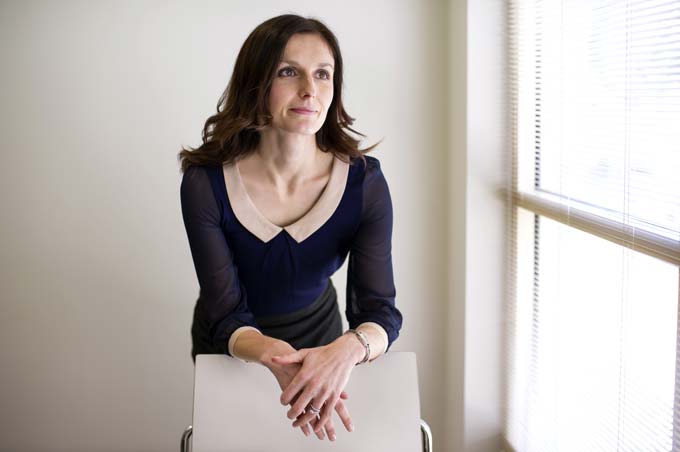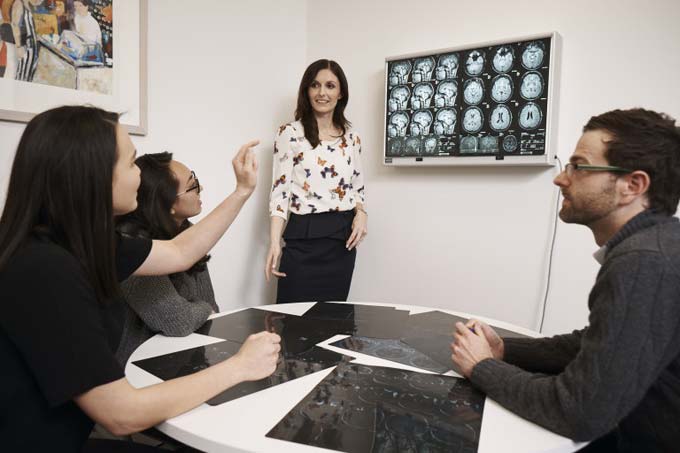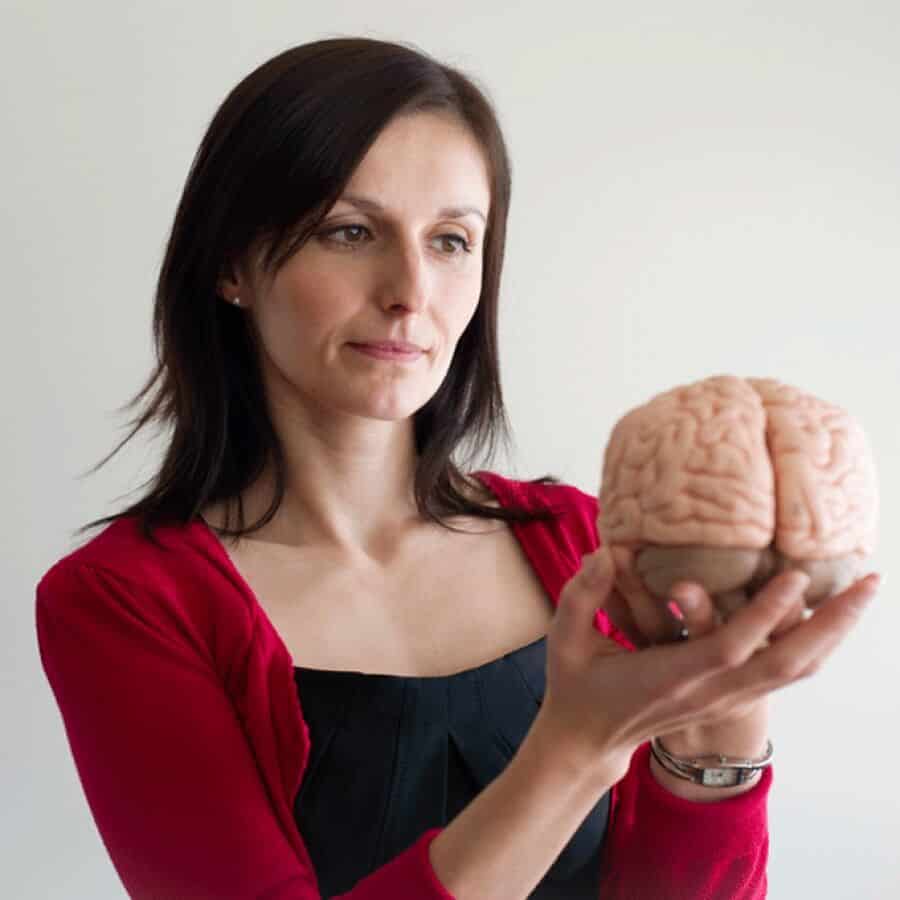Did you know that the memories of people with Alzheimer’s partly recover when they listen to the soothing notes of Vivaldi? Have you ever wondered why such people forget everything except how to love and give compassion? How much does genetics have to do with this cruel disease? One of the world’s leading experts in the field of Cognitive Neuroscience, Doctor Muireann Irish (36), reveals answers to these questions and gives extraordinary scientific updates regarding the study and treatment of Alzheimer’s disease. The moment her beloved grandmother was diagnosed with dementia was crucial for her career – she has devoted her life to understanding how the brain works and what drives the changes that lead to disease. This year, she was recognized as one of 15 International Rising Talents by the L’Oréal-UNESCO for Women in Science programme. She returned home determined to keep fighting for more recognition for women in science and with strong feeling of responsibility to pass on her knowledge and experience to the next generation of scientists.
Doctor Irish, one of the factors that inspired you to study psychology and later on neuroscience is the fact you wanted to know more about your remarkable ability to remember many details from your early childhood, unlike most of the people around you. After so many years, have you come to any conclusions as to why some of us remember more easily and more precisely than others, and what parts of our brains are responsible for this?
One of the big questions in cognitive neuroscience is how the brain enables us to remember the past in exquisite detail. This is a question that researchers have been endeavouring to understand for many decades, and while considerable progress has been made, the precise underlying neurobiology of human memory remains elusive. What we do know is that memory relies on the coordinated activity of many different regions in the brain, all of which must work together. Key regions include the hippocampus, a seahorse-shaped structure located deep within the brain, as well as the prefrontal cortex at the front of the brain, and lateral and parietal regions near the back of the brain. These regions work in concert to enable us to draw together the crux of the event, and to imbue it with sensory-perceptual details, emotional connotations, and self-referential feelings that enable us to re-experience an episode from the past. We all, however, have our different strengths in terms of memory, and while some people might remember the visual details from an event, others might show an aptitude for remembering names and faces. It remains unclear precisely what drives these individual differences, and this is an active area of research within the field.

Doctor Muireann Irish
Today, you are a recognized cognitive neuroscientist investigating memory processes and the impact of dementia. How did your grandmother’s Alzheimer’s influence what you do today?
My grandmother’s experience with Alzheimer’s disease was a pivotal moment in my life as it profoundly influenced the direction my career took. Growing up, I had a very close relationship with my ‘Nan’, as we would call in to see her before and after school. I often enjoyed sleeping over at her house and to be treated to hot cups of tea and warm buttery toast when I woke up in the morning. When I was seventeen, I started to notice that Nan wasn’t as precise as she used to be and could sometimes get confused easily. Nan had had a formidable memory and was a trailblazer in her town. As a midwife, she established her own nursing practice in Wexford, Ireland, and was responsible for the safe birth of many of the local residents. She could recite the names, dates, and birth weights of all of the babies born in her care, and she was often called upon as a reliable source of local history. It was a particularly cruel twist of fate, therefore, when her memory began to fail. It started as minor lapses, but soon progressed to her losing her way during a shopping trip in town, despite having walked the same route for decades. She became disoriented and agitated, and we feared for her safety living alone in her house. Finally, the diagnosis was confirmed, and our family had to make the extremely difficult decision to find a suitable care home for Nan. We were extremely fortunate that the staff of the nursing home she was in encouraged her to help out ‘on the wards’. That way, she was reliving her midwifery days, which gave her a sense of purpose and helped to orient her when she felt lost or could no longer recognise her surroundings. Gradually, however, Nan began to deteriorate, and towards the end of the disease, she was bed-bound, could no longer communicate verbally, and would instead grab my hand and squeeze it as she tried to utter something. I desperately wanted to know what was driving the changes in my Nan’s brain, so I decided to specialise in Cognitive Neuroscience during my degree and completed my honours dissertation on the use of music to boost memory processes in dementia. I found I had an intense curiosity and personal motivation to learn, to discover, and to make a meaningful difference for anyone suffering at the hands of this cruel disease. Nan sadly passed away while I was completing my final year at University, and I dedicated my thesis to her memory. Since then, I have been on a personal quest to understand how memory processes break down in dementia and what this reveals to us about the fundamental mechanisms of human memory. I completed a PhD on this topic and then relocated to Australia where I consolidated my research team and have pursued this line of research ever since. Nan will never know the profound influence that she had on my career, but she is never far from my thoughts.
What do your latest studies show about the early signs of Alzheimer’s disease?
We tend to associate Alzheimer’s disease with loss of memory for the past, but our latest research indicates that these difficulties extend to thinking about the future. In parallel with memory impairments, individuals with Alzheimer’s find it extremely difficult to mentally project themselves forwards in time to envisage events that might occur in the future. Across a series of studies, we have demonstrated that imaginative capacity is compromised in Alzheimer’s, ranging from an inability to simulate personally relevant events in the future, to an impaired capacity to mentally construct rich scenes in the mind’s eye. We rely upon these imaginative processes in our daily lives to anticipate, plan and predict, and it remains unclear how loss of these complex capacities impacts the daily life of the affected individual. We suspect that an inability to imagine the future may relate to lower mood, loss of motivation, and social withdrawal, and we intend to further explore the potential links between future thinking and wellbeing in dementia. More recently, my research team has discovered that patients with dementia do not daydream with the same frequency or intensity as we commonly do in our daily lives. Collectively, these symptoms relate to the breakdown of large-scale brain networks and point to a constellation of cognitive symptoms that have previously gone undetected in dementia.
Many people whose loved ones suffer from Alzheimer’s are secretly afraid the cause of the disease lies in genetics. What does science say regarding this matter? Does Alzheimer’s have roots in the genetic codes of our ancestors that might endanger us?
Watching a loved one suffer from any condition naturally causes distress as well as fear and anxiety about one’s own mortality and health. At present, our knowledge of the genetics of Alzheimer’s disease is incomplete, however, it is becoming clear that certain genes may make an individual susceptible. Of these candidate genes, the ApoE-ε4 is most commonly discussed in the media, but it is important to note that having this gene does not necessarily mean that you will develop the disease; it merely means that your chances of developing Alzheimer’s are higher than that of the general population. The same can be said in relation to lifestyle factors such as smoking, drinking large quantities of alcohol, or consuming a high-cholesterol diet, all of which increase your risk comparably.
Most cases of Alzheimer’s disease in people over the age of 65 years are “sporadic”, meaning there is no clear underlying genetic cause. Notably, however, for individuals who develop younger-onset dementia, (i.e., before the age of 65 years), three rare genes have been strongly implicated (APP, PSEN1, PSEN2). If you have one of those genes, unfortunately you will develop Alzheimer’s, and this is compounded by a 50% risk that your children will inherit the gene and thus the disease. These cases of dementia are extremely rare, and most often, the family is patently aware of the strong familial risks. Testing for the presence of these genes earlier in life can therefore be extremely important in making life decisions, such as whether or not to have children, and ensuring that appropriate considerations are made for end of life care.
Patients with Alzheimer’s disease generally remain warm and compassionate despite their cognitive decline. Can you tell us more about the brain’s remarkable ability to preserve empathy in the face of this illness?
While many cognitive processes such as memory, attention, and navigation are compromised in Alzheimer’s disease, the capacity to empathise and connect with others remains largely intact, at least in the early stages of the disease. Empathy is a complex construct to assess, but it is generally agreed that cognitive and affective processes are involved. We recently demonstrated that despite their cognitive difficulties, individuals with Alzheimer’s remain engaged and warm, displaying relatively preserved affective empathy, i.e., the capacity to understand and share the emotional experience of another person. In contrast, we found that individuals with frontotemporal dementia (a younger-onset neurodegenerative disorder) display striking changes in empathy, manifesting in blunted affect, and cold, sometimes callous behaviour. Using neuroimaging techniques, we found that empathy disruption in frontotemporal dementia was attributable to cell loss in frontoinsular regions of the brain, whereas these frontal brain regions remained largely preserved in Alzheimer’s disease. Our study thus provided important empirical data to suggest that changes in personality and interpersonal functioning in certain types of dementia manifest due to distinct profiles of atrophy in the brain. Alterations in personality and behaviour are some of the most upsetting aspects of caring for persons with dementia, and we hope that the insights provided by our study will enable carers to better adapt and cope with these distressing changes.
Why do people with Alzheimer’s stop communicating verbally?
Alzheimer’s disease is a progressive disorder, meaning that it continues to erode the functional networks of the brain, and this results in the breakdown of distinct cognitive processes. In the early stages of the disease, recent memory and visuospatial functions are typically affected, but as pathology spreads throughout the brain, other functions such as language, attention, and speech production are compromised. In the later stages of the disease, the individual is no longer able to communicate verbally, and may rely upon familiar short phrases, simple words, or even non-verbal gestures and sounds to convey what they are experiencing. It is imperative therefore that even when language processes break down, we remain sensitive and open to non-verbal forms of communication, even those that might be perceived as ‘challenging’, as this becomes the individual’s sole means of conveying their lived experience.

Doctor Muireann Irish
In your research project at Dublin’s Trinity College, you discovered that soothing music such as Vivaldi’s Four Seasons is helpful in rehabilitating memory in patients with Alzheimer’s. What leads to this, and can you name other, similar mechanisms that help?
This study remains one of my favourite pieces of work since commencing my research career. We were keen to explore the potential mechanisms by which familiar music may augment or improve memory in dementia. For my honours dissertation, I conducted an ambitious study whereby I tested autobiographical memory performance in individuals with Alzheimer’s disease. Autobiographical memory, as the name suggests, refers to our personal history, our autobiography, and is incredibly important for our sense of continuity across subjective time. I tested patients in silence or in a music condition, using the Spring movement from Vivaldi’s Four Seasons. Patients returned one week later for retesting, and the conditions were counterbalanced. I also conducted assessments of sustained attention, measures of physiological arousal using skin conductance, and self-report of state and trait anxiety levels to try to uncover the process by which music might exert its enhancing effect. The results were astounding. Even when controlling for the order of testing, patients displayed significantly enhanced retrieval of their past memories when reminiscing during the music condition. This effect appeared to be driven by a reduction in anxiety, suggesting that the presence of background soothing music potentially operates via an anxiety-reduction mechanism. As a young researcher, I was very proud of this work, and even though I have not conducted studies on music for quite some time it is an area of research that I would like to return to.
Another award in your career CV is this year’s recognition as one of International Rising Talents 2017 by the L’Oréal UNESCO for Women in Science programme. How will this help you in future regarding your scientific work?
In March 2017, I had the great honour of being selected as 1 of 15 International Rising Talents by the L’Oréal-UNESCO for Women in Science programme. I had previously been the recipient of a L’Oréal-UNESCO Australia and New Zealand for Women in Science Award in 2015, and the international fellowship is the pinnacle of this awards programme. As part of the Rising Talent award, I was flown to Paris where I spent a week with 14 other early career researchers from around the globe. Aside from the monetary award, which can be used for childcare, conference travel, or research costs, we also participated in mentoring, coaching, and career development workshops, all of which were invaluable to stamp out impostor syndrome – a common issue in academia and one which seems particularly rife in female academics. It was an uplifting and empowering experience, and we returned to our home countries feeling a renewed sense of responsibility to pass on the benefits of this program to the next generation of scientists coming through the ranks.
We are all patently aware of the stark underrepresentation of women in science and the “leaky pipeline” of academia whereby incredibly talented women fall out of the system due to unconscious bias, lack of support, and myriad other factors. In Australia, where I work, less than 25% of female academics in STEM fields are professors, despite concerted efforts to redress this imbalance. One of the most valuable lessons I learned from the L’Oréal-UNESCO for Women in Science programme is the responsibility that we have to dispel the antiquated notion of “what a scientist looks like” and to promote a more inclusive image in terms of gender, race, culture, and sexuality. I was recently selected as one of 30 Superstars of STEM in Australia, in an effort to smash outdated stereotypes regarding women in science, and to ensure that younger girls are exposed to relatable positive role models of female scientists. This part of the programme has been incredibly rewarding as I have visited schools, participated in mentoring initiatives, and hopefully can inspire the next generation of scientists with my story.
By using advanced neuroimaging techniques, Associate Professor Muireann Irish explores the uniquely human capacity to remember the past and to imagine the future, with particular emphasis on how these processes are compromised in neurodegenerative disorders. She hopes the future will bring discoveries that will help all people affected by dementia. She is a devoted scientist, but also a proud mom of a 3 and a half year old son, Fionn. You can read more about her biography.
Photo credits: L’Oréal Australia/Scott Needham / private archive
Support us!
All your donations will be used to pay the magazine’s journalists and to support the ongoing costs of maintaining the site.
Share this post
Interested in co-operating with us?
We are open to co-operation from writers and businesses alike. You can reach us on our email at cooperations@youthtimemag.com/magazine@youthtimemag.com and we will get back to you as quick as we can.










